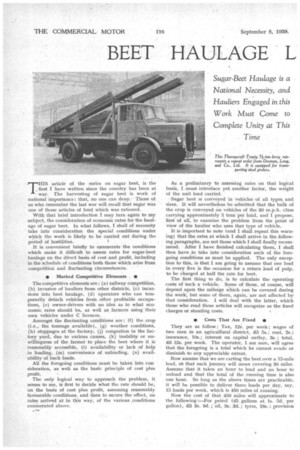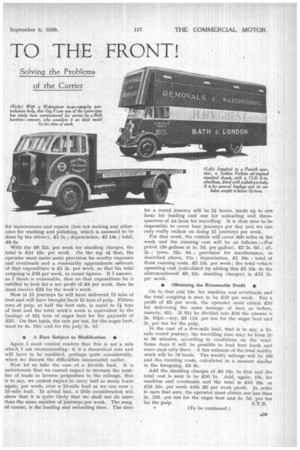BEET HAULAGE L TO THE FRONT!
Page 30

Page 31

If you've noticed an error in this article please click here to report it so we can fix it.
THIS article of the series on sugar beet, is the first I have written since the country has been at war. The harvesting of sugar beet is work of national importance : that, no one can deny.. Those of us who remember the last war will recall that sugar was one of those articles of food which was rationed.
With that brief introduction I may turn again to my subject, the consideration of economic rates for the haulage of sugar beet. In what follows, I shall of necessity take into consideration the special conditions under which the work is likely to be carried out during the period of hostilities. I It is convenient briefly to enumerate the conditions which make it difficult to assess rates for sugar-beet haulage on the direct basis of cost and profit, including in the schedule of conditions both those which arise from competition and fluctuating circumstances.
• Marked Competitive Elements • The competitive elements are; (a) railway competition, (b) invasion of hauliers from other districts, (c) incursions into beet haulage, (d) operators who can temporarily detach vehicles from .other profitable occupations, (e) owner-drivers with no idea as to what economic rates should be, as well as farmers using their own vehicles under C licences.
Amongst the fluctuating conditions are : (f) the crop (i.e., the tonnage available), (g) weather conditions, (h) stoppages at the factory, (j) congestion in the factory yard, due to various causes, (k) inability or unwillingness of the farmer to place the beet where it is reasonably accessible, (1) availability or lack of help in loading, (m) convenience of unloading, (n) availability of back loads.
All the foregoing conditions must be taken into consideration, as well as the basic principle of cost plus profit.
The only logical way to approach the problem, it seems to me, is first to decide what the rate should be, on the basis of cost plus profit, assuming reasonably favourable conditions, and then to secure the effect, on rates arrived at in this way, of the various conditions enumerated above. As a preliminary to assessing rates on that logical basis, I must introduce yet, another factor, the weight of the unit load carried.
Sugar beet is conveyed in vehicles of all types, and sizes. It will nevertheless be admitted that the bulk of the crop is conveyed on vehicles of the 30 m.p.h. class carrying approximately 5 tons per load, and I propose, first of all, to examine the problem from the point of view of the haulier who uses that type of vehicle.
It is important to note (and I shall repeat this warning) that the rates at which I shall arrive in the following paragraphs, are not those which I shall finally recommend. After I have finished calculating them, I shall then have to take into consideration such of the foregoing conditions as must be applied. The only exception to this, is that I am going to assume that one load in every five is the occasion for a return load of pulp, to be charged at half the rate for beet.
The first thing to do, is to calculate the operating costs of such a vehicle. Some of these, of course, will depend upon the mileage which can be covered during the week, but some of them, again, are not affected by that consideration. I will deal with the latter, which those who read these articles will recognize as the fixed charges or standing costs.
• Costs That Are Fixed • They are as follow : Tax, 12s, per week; wages of two men in an agricultural district, £5 5s.; rent, 2s.; insurance, 10s.; interest on capital outlay, 3s, ; total, £6 I2s. per week. The operator, I am sure, will agree that the foregoing is a total which he cannot evade or diminish to any appreciable extent.
Now assume that we are carting the beet over a 15-mile lead, st, that each journey will mean covering 30 miles. Assume that it takes an hour to load and an hour to unload and that the total of the running time is also. one hour. So long as -the above times are practicable, it will be possible to deliver three loads per day, say, 15 loads per week, which is 450 miles of running.
Now the cost of that 450 miles will approximate to the following :—For _petrol (45. gallons at is. 5d. per gallon), £3 3s. 9d. oil, 3s...3d. ; tyres, 18s.; provision for maintenance and repairs (but not making any allowance for washing and polishing, which is assumed to be done by the driver), £1 7s. ; depreciation, £2 14s.; total, £8 6s.
With the £6 12s. per week for standing charges, the total is £14 18s. per week. On the top a that, the operator must make some provision for sundry expenses and overheads and a reasonably approximate estimate of that expenditure is El 2s, per week, so that his total outgoing is £16 per week, in round figures. If I assume, as I think is reasonable, that on that expenditure he is entitled to look for a net profit of £4 per week, then he must receive £20 for the week's work.
Now in 15 journeys he will have delivered 75 tons of beet and will have brought back 15 tons of pulp. Fifteen tons of pulp, at half the beet rate, is equal to 7-i tons of beet and the total week's work is equivalent to the haulage of 82i tons of sugar beet for the paymett of £20. On that basis, the rate per ton, for the sugar beet, must be 4s. 10d and for the pulp 2s. 5d.
• A Rate Subject to Modification • Again I must remind readers that this is not a rate which I am recommending: it is a theoretical rate and will have to be modified, perhaps quite considerably, when we discuss the difficulties enumerated earlier.
Now let us take the case of a 10-mile lead. It is unfortunate that we cannot expect to increase the number of loads in inverse proportion to the mileage, that is to say, we cannot expect to carry half as many loads again, per week, over a 10-mile lead as we can over tt. 15-mile lead. In actual fact, a little consideration will show that it is quite likely that we shall not do more than the same number of journeys per week. The snag, of course, is the loading and unloading time. The time for a round journey will be 22 hours, made up to one hour for loading and one for unloading and threequarters of an hour for travelling: It is thus seen to be impossible to cover four journeys per day and we can only really reckon on doing 15 journeys per week.
For that work, the vehicle will cover 300 miles in the week and the running cost will be as follows :-For petrol (30 gallons at is. 5d. per gallon), 22 2s. 6d. ; oil, 2s. ; tyres, 12s. 6d.; provision for maintenance, as described above, 17s.; depreciation, £1 16s. ; total of these running costs, £5 10s. per week; the total vehicle operating cost (calculated by adding this £5 10s. to the aforementioned £6 12s. standing charges) is £12 2s. per week.
• Obtaining the Reasonable Profit • On to that add 18s. for sundries and overheads and the total outgoing is seen to be £13 per week. For a profit of £3 per week, the operator must obtain £16 for delivering the same tonnage of beet as before, namely, 82s. If 824 be divided into £16 the answer is 3s100.-say, £3 11d, per ton for the sugar beet and .2s. per ton for the pulp.
In the case of a five-mile lead, that is to say, a 10mile round journey, the travelling time may be from 20 to 30 minutes, according to conditions on the -road. Some days it will be possible to lead four loads and some days only three. A fair estimate of the total weekly work will be 18'loads. The weekly mileage will he 180 and the running costs, calculated in a manner similar to the foregoing, £3 Os.
Add the standing charges of £6 12s. to that and the total cost is seen to be £10 is. Add, again, 15s. for sundries and overheads and the total is £10 16s. or £13 16s. per week with £3 per week profit. In order to earn that sum, the operator must obtain not less than 2s. 10d. per ton for the sugar beet andls. 5d per ton
for the pulp. S.T.R.
• (To be continued.)




































































